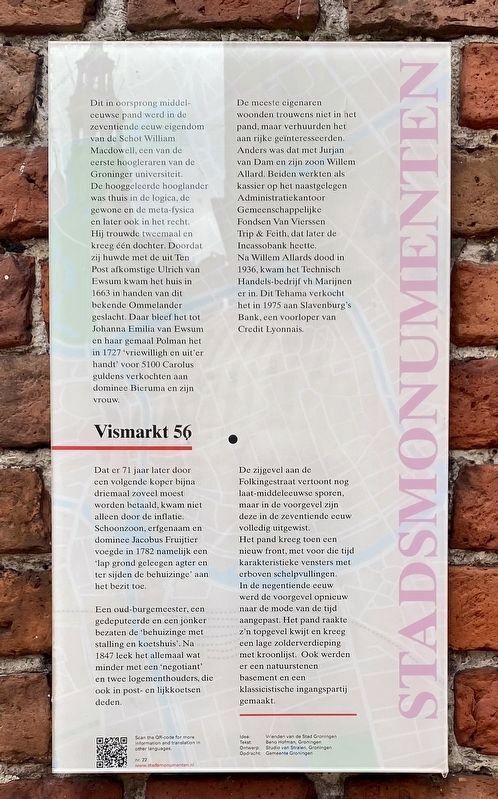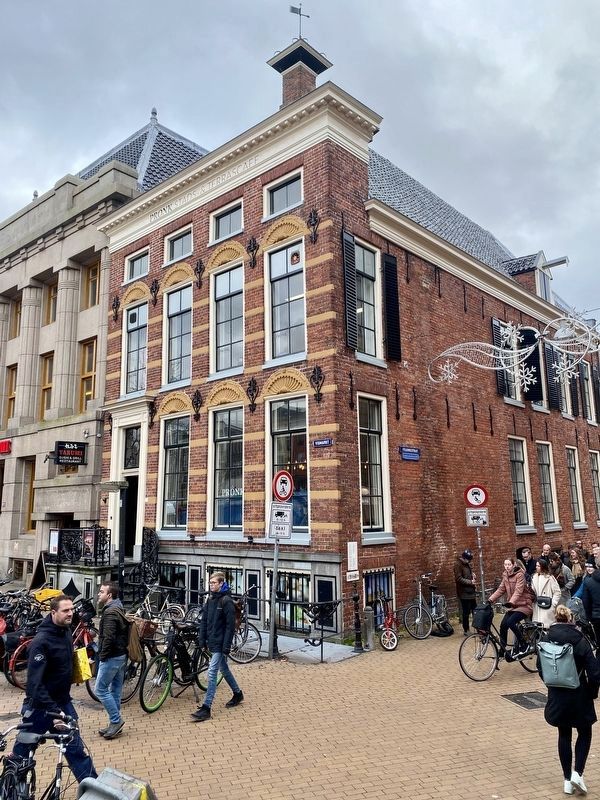Groningen, Netherlands — Northwestern Europe
Vismarkt 56
— Stadsmonumenten —
Dit in oorsprong middeleeuwse pand werd in de zeventiende eeuw eigendom van de Schot William Macdowell, een van de eerste hoogleraren van de Groninger universiteit. De hooggeleerde hooglander was thuis in de logica, de gewone en de metafysica en later ook in het recht. Hij trouwde tweemaal en kreeg één dochter. Doordat zij huwde met de uit Ten Post afkomstige Ulrich van Ewsum kwam het huis in 1663 in handen van dit bekende Ommelander geslacht. Daar bleef het tot Johanna Emilia van Ewsum en haar gemaal Polman het in 1727 ‘vriewilligh en uit’er handt’ voor 5100 Carolus guldens verkochten aan dominee Bieruma en zijn vrouw. Dat er 71 jaar later door een volgende koper bijna driemaal zoveel moest worden betaald, kwam niet alleen door de inflatie. Schoonzoon, erfgenaam en dominee Jacobus Fruijtier voegde in 1782 namelijk een ‘lap grond geleegen agter en ter sijden de behuizinge’ aan het bezit toe.
Een oud-burgemeester, een gedeputeerde en een jonker bezaten de ‘behuizinge met stalling en koetshuis’. Na 1847 leek het allemaal wat minder met een ‘negotiant’ en twee logementhouders, die ook in post- en lijkkoetsen deden. De meeste eigenaren woonden trouwens niet in het pand, maar verhuurden het aan rijke geïnteresseerden. Anders was dat met Jurjan van Dam en zijn zoon Willem Allard. Beiden werkten als kassier op het naastgelegen Administratiekantoor Gemeenschappelijke Fondsen Van Vierssen Trip & Feith, dat later de Incassobank heette. Na Willem Allards dood in 1936, kwam het Technisch Handelsbedrijf vh Marijnen er in. Dit Tehama verkocht het in 1975 aan Slavenburg’s Bank, een voorloper van Credit Lyonnais.
De zijgevel aan de Folkingestraat vertoont nog laatmiddeleeuwse sporen, maar in de voorgevel zijn deze in de zeventiende eeuw volledig uitgewist. Het pand kreeg toen een nieuw front, met voor die tijd karakteristieke vensters met erboven schelpvullingen. In de negentiende eeuw werd de voorgevel opnieuw naar de mode van de tijd aangepast. Het pand raakte z’n topgevel kwijt en kreeg een lage zolderverdieping met kroonlijst. Ook werden er een natuurstenen basement en een classicistische ingangspartij gemaakt.
This originally medieval building was owned by the Scotsman William MacDowell in the 17th century. He was one of the first professors of the University of Groningen. The scholarly highlander worked in the field of logic, metaphysics and later in law. He got married twice and had one daughter. Because his dautghter married Ulrich Ewsumwhom
who was originally from Ten Post, the house became in 1663 part of the renown Ommerlander family. The building remained part of the family until Johanna Emilia Van Ewsum and her husband Polman "voluntarily" sold it for 5100 Crolus guilders to parson Bieruma and his wife.
The fact that the subsequent purchaser 71 years later, had to pay almost 3 times as much was not only due to inflation. The son in law, heir and parson James Fruijtier added a piece of land located behind and to the sides of the building in 1782.
A former mayor, a deputy and a noble man possessed the property with all its houses and stables. After 1847 it all seemed a bit less with a negotiator and two hosts who were also in charge of the post and corpse carriages. Most of the owners did not live in the building but rented it out to wealthy people. This was not the case for Jurjan van Dam and his son William Allard. They both worked as cashiers for the nearby Common Trust Funds Van Vierssen Trip & Feith, which would be later called the “Incassobank”. After the death of Willem Allards in 1936, the Technical Trading company vhMarijnen took residence. This company sold it to Slavenbrug’s bank in 1975, which was a predecessor of Credit Lyonnais.
The side wall of the Flokingestraat still shows late medieval traces, but in the 17th century, these were completely obliterated. The entrance of the building was then reformed and shaped by shell-filled windows which were characteristic of that time. In the nineteenth century, the facade was readjusted to the fashion of that time. The building lost its gable and it was replaced by a low attic with cornice. Also, a natural stone basements and a classical entrance were constructed.
Erected by Gemeente Groningen. (Marker Number 22.)
Topics and series. This historical marker is listed in these topic lists: Architecture • Education • Industry & Commerce. In addition, it is included in the Groningen Stadsmonumenten series list. A significant historical year for this entry is 1663.
Location. 53° 13.003′ N, 6° 33.844′ E. Marker is in Groningen. Marker is at the intersection of Folkingestraat and Vismarkt, on the right when traveling north on Folkingestraat. Touch for map. Marker is at or near this postal address: Vismarkt 56, Groningen 9711, Netherlands. Touch for directions.
Other nearby markers. At least 8 other markers are within walking distance of this marker. Sociaal Democratische Bond / Social Democratic Union (a few steps from this marker); Vereeniging van Groningen Handelaren / Groningen Merchants Association (1847 - 1992) (a few steps from this marker); Oprichting van de Loge / Establishment of I.O.O.F. Lodge (a few steps from this marker); Korenbeurs / Grain Exchange (a few steps from this marker); Vismarkt 40 (within shouting distance of this marker); A-Kerk / A-Church (about 150 meters away, measured in a direct line); Het Soephuis / The Soup House (about 150 meters away); Evert Jan Thomassen à Thuessink (about 180 meters away). Touch for a list and map of all markers in Groningen.
Credits. This page was last revised on December 31, 2023. It was originally submitted on December 3, 2022, by Andrew Ruppenstein of Lamorinda, California. This page has been viewed 83 times since then and 16 times this year. Photos: 1, 2. submitted on December 3, 2022, by Andrew Ruppenstein of Lamorinda, California.

